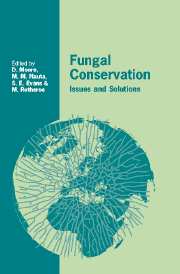Book contents
- Frontmatter
- Contents
- List of contributors
- Preface
- 1 Fungal conservation issues: recognising the problem, finding solutions
- 2 Current trends and perspectives for the global conservation of fungi
- 3 Conservation and management of forest fungi in the Pacific Northwestern United States: an integrated ecosystem approach
- 4 The future of fungi in Europe: threats, conservation and management
- 5 Fungi as indicators of primeval and old-growth forests deserving protection
- 6 Recognising and managing mycologically valuable sites in The Netherlands
- 7 Threats to hypogeous fungi
- 8 Wild mushrooms and rural economies
- 9 Threats to biodiversity caused by traditional mushroom cultivation technology in China
- 10 A preliminary survey of waxcap grassland indicator species in South Wales
- 11 Grasslands in the coastal dunes: the effect of nature management on the mycota
- 12 The conservation of fungi on reserves managed by the Royal Society for the Protection of Birds (RSPB)
- 13 Strategies for conservation of fungi in the Madonie Park, North Sicily
- 14 Fungal conservation in Ukraine
- 15 The threatened and near-threatened Aphyllophorales of Finland
- 16 Fungal conservation in Cuba
- 17 Microfungus diversity and the conservation agenda in Kenya
- 18 Fungi and the UK Biodiversity Action Plan: the process explained
- 19 The Scottish Wild Mushroom Forum
- 20 The contribution of national mycological societies: establishing a British Mycological Society policy
- 21 The contribution of national mycological societies: the Dutch Mycological Society and its Committee for Fungi and Nature Conservation
- 22 Fungal conservation in the 21st century: optimism and pessimism for the future
- Index
9 - Threats to biodiversity caused by traditional mushroom cultivation technology in China
Published online by Cambridge University Press: 13 October 2009
- Frontmatter
- Contents
- List of contributors
- Preface
- 1 Fungal conservation issues: recognising the problem, finding solutions
- 2 Current trends and perspectives for the global conservation of fungi
- 3 Conservation and management of forest fungi in the Pacific Northwestern United States: an integrated ecosystem approach
- 4 The future of fungi in Europe: threats, conservation and management
- 5 Fungi as indicators of primeval and old-growth forests deserving protection
- 6 Recognising and managing mycologically valuable sites in The Netherlands
- 7 Threats to hypogeous fungi
- 8 Wild mushrooms and rural economies
- 9 Threats to biodiversity caused by traditional mushroom cultivation technology in China
- 10 A preliminary survey of waxcap grassland indicator species in South Wales
- 11 Grasslands in the coastal dunes: the effect of nature management on the mycota
- 12 The conservation of fungi on reserves managed by the Royal Society for the Protection of Birds (RSPB)
- 13 Strategies for conservation of fungi in the Madonie Park, North Sicily
- 14 Fungal conservation in Ukraine
- 15 The threatened and near-threatened Aphyllophorales of Finland
- 16 Fungal conservation in Cuba
- 17 Microfungus diversity and the conservation agenda in Kenya
- 18 Fungi and the UK Biodiversity Action Plan: the process explained
- 19 The Scottish Wild Mushroom Forum
- 20 The contribution of national mycological societies: establishing a British Mycological Society policy
- 21 The contribution of national mycological societies: the Dutch Mycological Society and its Committee for Fungi and Nature Conservation
- 22 Fungal conservation in the 21st century: optimism and pessimism for the future
- Index
Summary
Introduction
China is the world's major mushroom producing country. Agaricus production is mainly for export but Lentinula edodes (shiitake or shiang-gu) is the traditional local product, and now the major crop. Lentinula edodes is indigenous to China. It was first cultivated there more than 800 years ago, and today, China accounts for about 70% of world production. In 1997, Chinese production was recorded as 91 500 metric tonnes of the dried crop (drying produces the characteristic taste of the mushroom), ten times that in fresh weight. Shiang-gu (the Chinese name) is presently about the second or third most popular cultivated mushroom in the world, being consumed throughout China, Taiwan, Japan and Korea, and with increasing world-wide popularity. One-third of the Chinese crop is exported. As this amounts to the equivalent of about 300 000 tonnes of fresh mushrooms, the industry is an important earner of foreign exchange as well as making a very significant contribution to the income of peasant-farmers especially of the mountainous regions in China (Chang & Chiu, 1992). In these regions the land is poor in fertility and too distant from reliable transport to make conventional farming of green crops profitable.
Traditional technology
The traditional log-pile cultivation method is still the one that is most frequently used. For this, locally felled logs (oak, chestnut, hornbeam, maple and other trees) over 10 cm diameter (probably about 20 to 30 years old) and 1.5 m to 2 m long are normally cut in spring or autumn of each year.
- Type
- Chapter
- Information
- Fungal ConservationIssues and Solutions, pp. 111 - 119Publisher: Cambridge University PressPrint publication year: 2001
- 7
- Cited by



